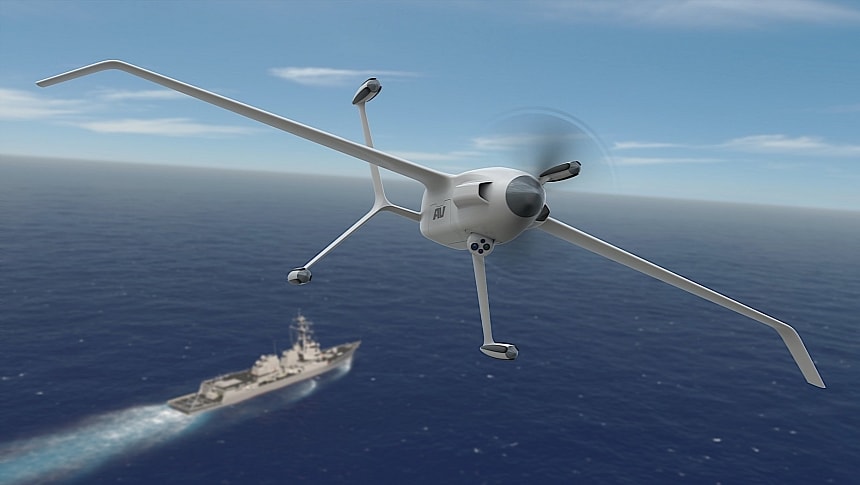The American Defense Advanced Research Projects Agency (DARPA) is presently engaged in a large number of projects meant to bring to light drone designs with new capabilities. The talk of the moment, however, is something called ANCILLARY.
ANCILLARY stands for AdvaNced airCraft Infrastructure-Less Launch And RecoverY, and it's an effort that seeks to create uncrewed aircraft systems (UAS, that's the official name for drones) that can be used by the U.S. Navy and Marines.
These military branches mostly operate from ships at sea, which means there's only so much space for complicated launch and recovery gear to be installed. That's why DARPA is looking for drones that can launch and land vertically.
That's not a very hard thing to do, but that requirement comes with strings attached. The drones must also be lightweight and able to carry a 60-pound (27 kg) payload. The aircraft should be capable of reaching distances as far as 518 miles (833 km), and must come with 12 hours endurance time.
Back in the summer of last year, DARPA announced the companies that will be competing in the ANCILLARY program. There were nine of them: AeroVironment, AVX Aircraft, Griffon Aerospace, Karem Aircraft, Leidos, Method Aeronautics, Northrop Grumman, Piasecki Aircraft, and Sikorsky.
Close to a year after that announcement, some of these companies announced they were moving into the next phase of the program and gave us the first glimpse at the machines they are working on.
We've already had a look at the design helicopter maker Sikorsky is working on, and we've also talked about the drone Northrop Grumman proposal. This time we're going to focus on what defense contractor AeroVironment brings to the table.
At first glance it would seem AeroVironment has a bit of an upper edge over its competitors, for the simple reason that the company has been making military drones since forever, it seems. Large fleets of its products, meaning the Raven, Puma AE, and JUMP, are in operation in the hand of militaries around the world, but for the ANCILLARY program the company is proposing something else.
This drone is called Wildcat, and it's a tail-sitting vertical take-off and landing (VTOL) aircraft. It has been specifically designed to operate from Navy ships "in challenging maritime environments."
The full details of the drone have not been disclosed, but we do know it uses machine learning-enabled computer vision that should allow it to excel at conducting the intelligence, surveillance, and reconnaissance (ISR) missions the Navy will assign it to perform.
One key aspect of the Wildcat is that it has the ability to dash over 115 mph (185 kph) "to quickly cover long distances over sea or land." AeroVironment says the Wildcat will be able to operate as part of a larger fleet, meaning it also packs collision avoidance systems.
DARPA plans to have a functional drone developed under the ANCILLARY program sometime in 2026, meaning it's too early to tell which of the proposed designs will actually make it into production.
These military branches mostly operate from ships at sea, which means there's only so much space for complicated launch and recovery gear to be installed. That's why DARPA is looking for drones that can launch and land vertically.
That's not a very hard thing to do, but that requirement comes with strings attached. The drones must also be lightweight and able to carry a 60-pound (27 kg) payload. The aircraft should be capable of reaching distances as far as 518 miles (833 km), and must come with 12 hours endurance time.
Back in the summer of last year, DARPA announced the companies that will be competing in the ANCILLARY program. There were nine of them: AeroVironment, AVX Aircraft, Griffon Aerospace, Karem Aircraft, Leidos, Method Aeronautics, Northrop Grumman, Piasecki Aircraft, and Sikorsky.
Close to a year after that announcement, some of these companies announced they were moving into the next phase of the program and gave us the first glimpse at the machines they are working on.
We've already had a look at the design helicopter maker Sikorsky is working on, and we've also talked about the drone Northrop Grumman proposal. This time we're going to focus on what defense contractor AeroVironment brings to the table.
At first glance it would seem AeroVironment has a bit of an upper edge over its competitors, for the simple reason that the company has been making military drones since forever, it seems. Large fleets of its products, meaning the Raven, Puma AE, and JUMP, are in operation in the hand of militaries around the world, but for the ANCILLARY program the company is proposing something else.
This drone is called Wildcat, and it's a tail-sitting vertical take-off and landing (VTOL) aircraft. It has been specifically designed to operate from Navy ships "in challenging maritime environments."
The full details of the drone have not been disclosed, but we do know it uses machine learning-enabled computer vision that should allow it to excel at conducting the intelligence, surveillance, and reconnaissance (ISR) missions the Navy will assign it to perform.
One key aspect of the Wildcat is that it has the ability to dash over 115 mph (185 kph) "to quickly cover long distances over sea or land." AeroVironment says the Wildcat will be able to operate as part of a larger fleet, meaning it also packs collision avoidance systems.
DARPA plans to have a functional drone developed under the ANCILLARY program sometime in 2026, meaning it's too early to tell which of the proposed designs will actually make it into production.






